Anchoring Systems
Trident protective polymeric films do an incredible job of holding glass together as a defensive shield but they do not hold the broken glass in the window frame under the most extreme stress. If a force is Powerful enough, filmed glass can be ejected out of the frame. The expulsion of filmed glass is far less dangerous than a shower of shards from uncoated glass but a high velocity impact would still cause serious injury. In applications where the purpose is local blast protection, you are not sufficiently protected unless the two are somehow connected. It was this need that lead to the development of anchoring /edge retention systems.
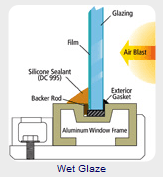
The 3 categories of anchoring systems:
Wet Glaze, Screwed Mechanical and Glued Mechanical.
Each has benefits and drawbacks.
The Wet Glaze method involves removing the rubber gaskets from the window frame and replacing it with Dow 995 Silicone, which overlaps the frame, glass and film anchoring them all together. The positives of this system are lower cost and flexibility for different frame types. Done correctly the Wet Glaze can be clean and nearly unnoticeable, done poorly – watch out for the mess.
The “Screwed Mechanical” uses a metal angled frame, which is literally screwed into the frame and potentially the wall. The film is installed “oversized” to allow a wrap under the metal frame and then screws are placed through the anchoring frame/film into the window frame tying together the system. Screwed Mechanical systems are often the strongest option because of the wrap of film under the anchoring frame and longer screws can sometimes be used to increase anchorage of the frame to the building potentially greatly increasing protection. Drawbacks include high cost and permanent nature of the installation. Your frames will have holes in them if you ever wanted to remove the anchoring system.
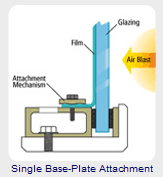
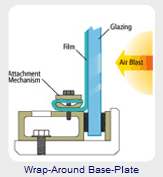
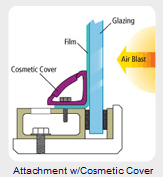
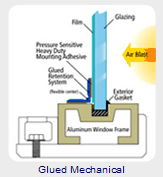
The “Glued Mechanical” system is an adhesive backed anchor medium. They can beflexible or stiff but they come with adhesive already applied to one side. The installation is a relatively simple process of removing the protective backing strips and applying the adhesive side across the glass/frame edge. This is the easiest type of retention system to install so less experience may be required. They are generally not as strong as top of the line screwed in systems and since they are applied only on the surface of the film and the frame, they cannot help anchor the frame to the wall.
The idea is that the glass is attached to the film by adhesive, the film is attached to the frame with a retention system and the frame is attached to the building by screws. Anchoring or Edge Retention systems are designed to be the middle link in a chain of connections that turn your windows into a single defensive unit. It is important to keep the “chain” analogy in mind as you consider defensive protective measures. In other words, you can do a wonderful job of anchoring the film/glass to the frame; however if the frame to building connection is the “weak link” the window will still blow out with the frame attached! Ouch! Anchoring Safety and Security window film is about creating defensive systems, which include the glass, the film, the frame and the building in one continually reinforced chain.
We are including descriptions of several retention systems here for your information to help you understand some of the systems that may be proposed to you. We have performed tests proving the strength of our films and anchoring systems but alone that says little about the correct solution for your application. Please contact a local window film professional who specializes in blast protection films and edge retention systems. Confirm their references and experience, as this is not a standard window film installation. It is a good idea to visit one of their previous installations to see how it looks and how the customer relates the experience/results. Once you have confirmed that you are working with a competent, experienced professional, take their advice seriously!
- Learn More
- Anti-Graffiti / Vandalism
- Residential Safety
- Commercial Security
- Windstorms
- SEISMIC
- Bomb Blast/ Terrorism
- Anchoring Systems
